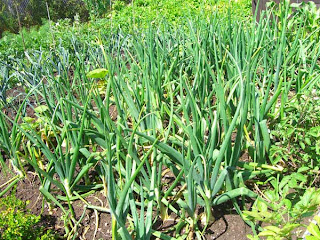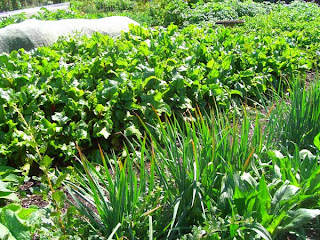Just after I started I remembered that I wanted to take some pictures of the allotment in July. July is a cropping month and this means that the allotment is beginning to look a little untidy. Where crops have been harvested and new crops planted everything looks a little dishevelled. I do not grow to look pretty though. This is a working allotment and crops are grown to produce food. I do not grow for exhibition or for competition; I grow for food.
The champaign rhubarb has suddenly made a great deal of growth as have the Victoria rhubarb in the background. I might start to harvest this again later this month.
Next years raspberry fruiting canes have grown very big. The next job must be to tie these into the wire support frame. I usually do this after I have cut out all of this years fruiting canes but these canes are still fruiting so I am not going to cut them out until I have finished harvesting them. The old canes are the ones with yellowy leaves. They will be cut out at ground level when they have finished cropping.
The Kestrel and Pink Fir Apple potatoes are still looking green. I cannot see any blight on them yet but I am keeping a vigilant eye on them. The rain today will go to making the tubers bigger. I do not want to crop these until the tops die off completely. All this goodness in the tops needs to be taken down into the tubers. Several of the allotment holders want me to dig them up to see what kind of crop I have. I am not expecting to have a spectacular crop.
 |
| Potatoes looking north east |
As you can see the potatoes are planted right up to the raspberries. They seem to be completely happy growing next to each other. There is no blight at the moment. Raspberries and potatoes can grow together very happily. They may not be the best of companion plants but they do not have any adverse effects on each other. So where the "don't plant potatoes next to raspberries" came from I don't know. They are fine together. The Pink Fir Apple next to the raspberries was about 4ft tall, although now they have fallen down a bit due to the rain.
 |
| Potatoes looking south east |
 |
| Oca |
I think that the oca will grow a bit bigger in August. You can just see the Totem tomatoes in the background. I have my first red one on one of these plants. I am a bit concerned with one of the container tomatoes by the shed. I think that it might have blight.
The lettuce are going over now. I am not too concerned because I have a lot of succession lettuce in the bed and we can easily start to eat those now. A lot of these lettuces have a stem rot and it is making them flop about. The celeriac seems to have taken quite well.
 |
| The lettuce are going over now |
The broad beans have been planted after the garlic was harvested. I have left the garlic in the store shed to dry off really well. The broad beans are flowering now but I really just want them for a green manure. The seed was given to me last year and I didn't think that they would germinate but here they are.
 |
| The onions don't look too good. They might have white rot. |
Trying to grow onions on the allotment is becoming more and more difficult. What with onion miner fly and white rot there does not seem to be any incentive to grow them. I will be dead chuffed if I can get some this year.
Now that the sweet peas have reached the top of the support canes they will have to be layered. This means that they are taken off the canes and laid on the ground and taken up another cane further down the row.
 |
| Valerie Harrod and Restormel sweet peas layered |
 |
| Bristol sweet peas being layered |
 |
| Juvenile robin. |
This young robin was so close that I nearly trod on him several times. It had made the sweet peas its home. Getting so close to wildlife is one of the pleasures of gardening. I sometimes take this kind of encounter for granted but really they are to be treasured. How many other people have got this close to a juvenile robin. It was literally nearly under my feet.
 |
| Aintree runner beans. |
The Aintree runner beans don't get much sun on this side of the row because there is an oak tree shading them. I will take off the overhanging branches in the autumn and bury them in the subsoil. I have mowed the paths alongside the allotment and they look quite good now.
This side of the Aintree row gets much more sun and produces many more flowers. I hope that I get as many beans off these plants. As the bean stems reach the top of the support canes I cut them off. This encourages side shoots to form and start to grow up the canes. The more stems you get the more flowers there are and potentially the more beans you will get. Well that's the theory anyway.
 |
| Brassicae bed |
The Brussel sprouts seem to be doing well. They had a lot of cabbage white butterflies on them yesterday so they will have to be watched carefully and any caterpillars removed.
 |
| Squash Hunter |
 |
| New bay tree |
The peas have been harvested - except for one or two which I will collect when I take the plants out. That's why they are looking a little untidy. The plants are going yellow and this means that they will not produce any more edible peas. I will be digging these into the soil they were growing on and I will replace them with more peas. I have got some Kelvedon Wonder. I will plant them in some New Horizon's peat free compost in sectioned trays like I did with the Early Onward. When they are big enough and I have cleared this bed of the old pea plants I will plant them out and construct the chicken wire supports again.
The climbing French beans are beginning to grow well now. They are being over shaded by some sweet peas I put along the row. The courgettes growing under the climbing French beans are doing very well as well. However, when have courgettes not done well?
I must remember for next year to give plants a lot more room to breath. Too many are getting overshadowed particularly in the brassicae bed.



















No comments:
Post a Comment